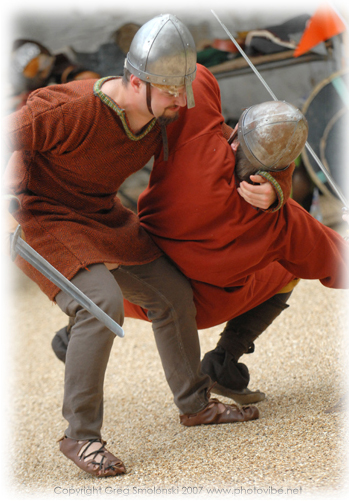 Battle Training
Battle Training
Every so often the Oxford police station gets a phone call saying "Err, there are some weird people with pointy hats and tunics fighting with steel and leather down here."
That's us. We hold battle practice every Sunday in Oxford term time at 1pm by Jackdaw Lane: see what3words.com/scrap.shot.area for the exact location.
Re-enactment fighting is a form of mock combat involving authentic replicas of Dark Age weapons. We use a variety of weapons including swords, shields and spears. They are made out of steel and have blunted edges. Most of us fight with sword and shield. Some people have their own weapons; otherwise the society provides members with helmets, shields and single-edged seaxes. However, fighting with sword and shield is only the beginning. Spears, hand axes, langseaxes, and the awesome Dane axe feature among the more experienced warriors. Like our ancestors of old we train to fight in the shield-wall.
We kick off with a warm up practising the basic attacks and parries. This is usually followed up by one-on-one or group fighting. We also practice shield-walls and wedge formations. Initial training is geared towards cooperative fighting to enable everyone to learn the the basic moves. Later, we move on to teaching competitive fighting. In competitive fighting the weapon is swung or thrust dramatically at the opponent: at the last moment the motion of the weapon is checked so that the gentlest of contact possible is made with the target area. Successful contact counts as a kill. For safety reasons we have defined the torso and the upper legs and arms as valid target areas. The head, elbows, knees, the spine, the obvoius tender parts are rigorously off limits. Lots of practice, caution and common sense make good fighters. Over the centuries we have come up with entertaining exercises to hone our skills. Circle of Honour, Circle of Treachery and Chase the Maiden are the classics.
After a lot of target practice people use archery in combat as well, firing arrows with blunted tips. The Anglo-Saxons used archery primarily for hunting as the sport of noblemen. However, there can be little doubt that bow and arrow were used in battle. It seems most likely that the bow was mainly used by freemen on the battlefield.
The Viking Lord looked perplexed. His taunts were not working. And then he shouted at us: 'I shall take your beer, and let it be known throughout the Danelaw that the sons of the Saxons dine on cowmilk!'The battlefield echoed with our cry of indignation. We arrayed ourselves in a battle line standing shoulder to shoulder, shields locked together. Any man charging home would be met by a wall of leather covered wood, bristling with spears. The Vikings shouted insults at us yet even so we noticed how slowly they came. When they were only fifty paces away they stopped altogether.
The Danes began beating their shields with their swords. The rattling sound was meant to unsettle us though none on our side showed fear. We stood firm waiting for the charge. The time had come to have faith in my shoulder companions. If they failed me the enemy would hack at my exposed flanks. One gap in the shield-wall could spell doom for us all.
(Extract from the Chronicles of Wychwood)
 Safety
Safety
Safety is the most important aspect of re-enactment combat. Combat supervisors are appointed at each practice to make sure that nobody does anything dangerous. Everybody learns the basics with wood, and passes on to steel when approved by one of the supervisors. It normally takes about two or three weeks to pass on to steel. Members are taught to pull their blows so as to minimise the force with which your weapons hits your opponent: if someone tells you that you are hitting them too hard, then you are. Our wiki includes a full explanation of risk and risk reduction and safety guidelines for weapons and armour.
We always wear padded gloves when fighting; we have enough for everybody to borrow. Helmets are compulsory when fighting with steel. For your first battle practice, turn up in comfortable clothes and sensible footwear: if you wear glasses, we recommend switching to contact lenses or, at least, glasses with plastic lenses. This is to reduce the risk of eye injury.
You cannot fight if you have drunk alcohol. Also, we do not fight in the dark.
